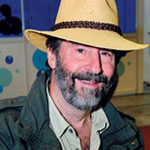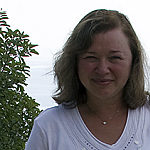South shore of Lake Chad near the village of Sangaria
The 2nd place in the qualifying stage of the Biotope Aquarium Design Contest 2013
![]() Russia. Vera Gladyshenko
Russia. Vera Gladyshenko

Volume: 140 L
List of fishes: Hemichromis bimaculatus, Polypterus senegalus
List of plants: Ceratophyllum demersum, Nymphaea lotus, Juncus and Cárex (instead of Cyperus papyrus and some others)
Biotope description: Chad is a very shallow lake with a very flat bottom (and its surface is not constant). Even in the greatest flood its depths never exceed 4 meters. Once in the basin of the main tributary of the Shari there is heavy rainfall and the river brings a lot of water to the lake, Chad immediately grows, flooding vast areas of flat low-lying coasts. And during the low water in Shari, the lake level is lowered and the area gets quickly smaller. Despite of these metamorphoses, the lake is the only large body of water in Central Africa. The water in different parts of the Lake Chad has different mineralization: in most parts it is salted, and fresh near the mouths of rivers. Scientists explain lower mineralization of water by the constant change of water in the lake due to the outflow of the lower layers of water to the underground. The western and southern shores are low, swampy and covered with dense vegetation, northern and eastern ones are cut up. There are many sandy islands formed by flooded dunes here. The most common species of water plants are Cyperus papyrus, Aeschynomene elaphroxylon, water lilies and reeds, Ceratophyllum demersum. The bottom is mostly sandy with silt brought by the waters of the Chari.

This is a very nice biotope and excellent description of Lake Chad and it feels like Vera has lived there. The biotope title matches and also the light effect is very well done. But the Polypterus found there is the large P. bichir.
One of the best tanks in this contest. The imitation of natural light is great. But – my first thought was: “Wow, exactly the same habitat like the one I saw in Eastern Poland, near Łomża – in an oxbow lake of the Narew river. All (or almost all) plants are exactly the same. Instead of stocking this tank with Polypterus, Vera could stock it with Central European fish, and the effect would be even more stunning.

It’ is a beautiful biotope. Rays of sun broke through the lily leaves, lighted a piece of sandy bottom, frightened Polypterus and attracted the attention of a school of African jewelfishes. Looking at the entry, I do not have feeling that this is an aquarium. The underwater landscape looks quite natural, the aquarium is fascinating and takes us to a distant Africa in the underwater world of Lake Chad. If you crop the picture so that sides of the aquarium were not visible, there will be a feeling of underwater photo. The sand bottom looks very natural, with a slight relief, a few leaves lightly covered with sand give natural feeling to the wole landscape. This entry is a good example of the fact that there is no need to cover the entire bottom with leaves too make a biotope aquarium. The floating leaves of water lilies look elegant, they are used in the entries not frequently, but they give a special charm and natural beauty to the aquarium, and fishes feel protected from predators from above. The branches are successfully used to simulate the coastal bushes, Ceratophyllum looks naturally in the overall composition, sedges leave no doubt that this is a real natural body of water. It can be seen that fishes feel well in this aquarium, demonstrating their natural behavior. The fishes are from this particular biotope. The nice picture strengthens the emotional impact on the viewer. In my opinion, by the power of the emotional impact it is the strongest biotope contest entry.
